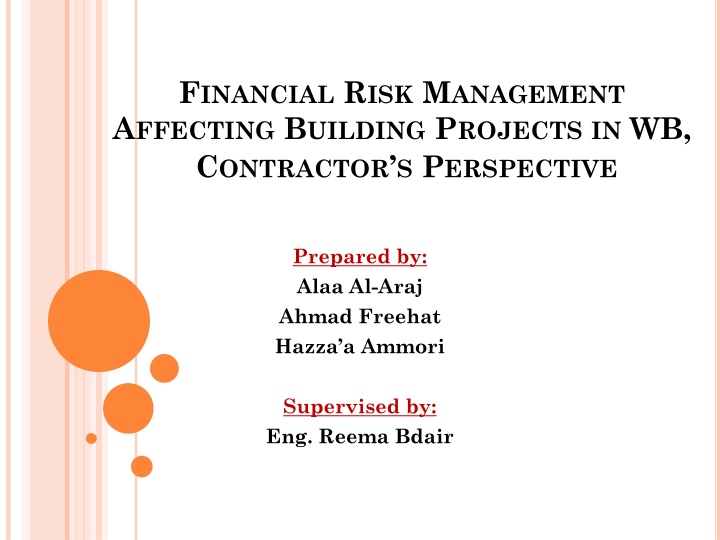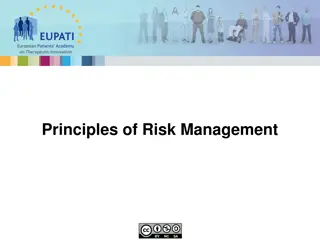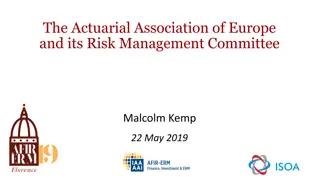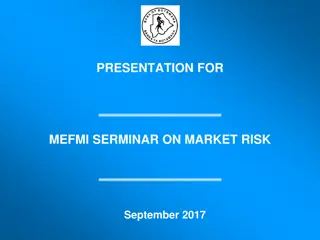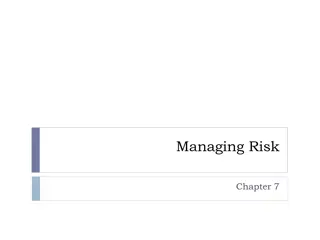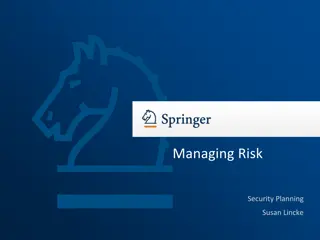FINANCIAL RISK MANAGEMENT
This study focuses on financial risk management in building projects from the perspective of contractors. It covers problem definition, research methodology, questionnaire analysis, and recommendations. The questionnaire assesses various aspects of financial risk factors affecting construction projects, such as severity, controllability, and estimation responsibility within companies. The research strategy combines quantitative and qualitative methods, primarily utilizing a questionnaire survey approach.
Download Presentation

Please find below an Image/Link to download the presentation.
The content on the website is provided AS IS for your information and personal use only. It may not be sold, licensed, or shared on other websites without obtaining consent from the author.If you encounter any issues during the download, it is possible that the publisher has removed the file from their server.
You are allowed to download the files provided on this website for personal or commercial use, subject to the condition that they are used lawfully. All files are the property of their respective owners.
The content on the website is provided AS IS for your information and personal use only. It may not be sold, licensed, or shared on other websites without obtaining consent from the author.
E N D
Presentation Transcript
FINANCIAL RISK MANAGEMENT AFFECTING BUILDING PROJECTS IN WB, CONTRACTOR S PERSPECTIVE Prepared by: Alaa Al-Araj Ahmad Freehat Hazza a Ammori Supervised by: Eng. Reema Bdair
RESEARCH METHODOLOGY 1. Problem definition, Research aim and Research objectives 2. Theoretical Background & Literature Review 3. Determination of R-Strategy 4. Questionnaire building and sample size determination. 5. Questionnaire analysis 6. Recommendations.
METHODOLOGY RESEARCH STRATEGY Research strategies are usually divided into two main types: 1- Quantitative research 2- Qualitative research This research mixes both of them but depends mainly on conducting questionnaire survey.
QUESTIONNAIRE FINAL FORM It consists of two parts : The first one asks about general questions related to the company and the questionnaire filler. ( 6 Questions ) The second one measures the degree of severity and controllability of 24 widespread and well- known financial risk factors.
QUESTIONNAIRE ANALYSIS Who filled out this form (his\her Career)? manager of the company Accountant Other Sub-manager Engineer 8% 42% 42% 8% 0%
QUESTIONNAIRE ANALYSIS Who is responsible for estimating financial risks that affect construction projects in your company? manager of the company Accountant Other Sub-manager Engineer 0%0% 0% 8% 92%
QUESTIONNAIRE ANALYSIS How many experience years does your company have in construction sector? less than 5 years (10-15) year other( ..................) (5-10) years (15-20) year 0% 17% 33% 17% 33%
QUESTIONNAIRE ANALYSIS What is the system adopted by the company in the financial risk assessment, its impact and the ways to minimize them? Computerized programs Expertise and experience A mixture of the two sides other (..............) 0% 0% 17% 83%
QUESTIONNAIRE ANALYSIS How many full time employees does your company have? less than 10 (10- 20) (21-30) (31-40) other(............) 0% 17% 33% 33% 17%
QUESTIONNAIRE ANALYSIS In general and from your own perspective, is your company able to predict the probable financial risks? Always Often Sometimes Never 0% 8% 42% 50%
QUESTIONNAIRE ANALYSIS The severest ten main factors in term of the degree of severity were: Bankruptcy of the owner or financier. Delays in payments: Contractor's debts before the start of the project (Existing debt). Monopolization of materials and equipment as a result of Israeli closures and unforeseen political conditions. Foreign currency fluctuation and Exchange rate fluctuation. Error in the previous estimate for the project and its related costs account (Unsound pre-estimation of the project cost.) Inflation Labor strikes Contractor's bankruptcy 10. Inadequate terms and conditions in tender documents. 1. 2. 3. 4. 5. 6. 7. 8. 9.
QUESTIONNAIRE ANALYSIS The top ten factors in terms of the degree of being out of control where: Monopolizing of materials due to closure and other unexpected political conditions. Bankruptcy of the funder or the owner Take-up of shares Financial failure of the contractor (insufficient funding/ Contractor s bankruptcy) Foreign currency fluctuation and Exchange rate fluctuation Inflation Source of loan delay in payments labor strikes 10. Delay in the first payment. 1. 2. 3. 4. 5. 6. 7. 8. 9.
Risky Factor Severity Controllability Delay in Payments 1 Very Severe Moderate Delay in the first payment specially 2 Moderate controllable Moderate Foreign currency fluctuation and Exchange rate fluctuation 3 severe Inflation severe Moderate 4 Inadequate terms and conditions in tender documents. severe controllable 5 Having to break up partnerships between companies, in a project or both controllable 6 Moderate Labor strikes severe controllable 7 Unsound pre-estimation of the project cost. severe controllable 8 Financial failure of the contractor (insufficient funding/ Contractor s bankruptcy) severe Moderate 9 Bankruptcy of the funder or the owner Moderate 10 Very severe severe Lack of financial liquidity management during the project 11 controllable Monopolizing of materials due to closure and other unexpected political conditions. Very severe 12 Moderate Fraud severe controllable 13 Performance bond requirements Moderate controllable 14 Interest Type (Fixed, Floating, or capped) Moderate controllable 15 Changes in interest rate Moderate controllable 16 Availability of loan Moderate controllable 17 Loan period Moderate controllable 18 Source of loan Moderate 19 Moderate controllable Existing debt Very severe 20 Insurance Moderate controllable 21 Taxes controllable 22 severe Time and amounts of dividend payments controllable 23 Moderate Take-up of shares 24 Mild Moderate
RECOMMENDATIONS 1- Bankruptcy of the financier or the owner: If the contractor feels that the case here will occur, he shall try to get a bank guarantee which ensures that the owner or the funder has the ability to pay. 1. Avoiding taking projects which are funded by the Palestinian financial ministry. 2.
2- Delay in payments (1) Asking for advanced or mobilization payment (2) Loading of rates (3) Adjustment of work schedule to late start timing.. (4) Reduction of delays in receiving revenues. (5) Achievement of maximum production in the field to increase the monthly payments. (6) Reducing the retention. (7) Adjust the timing of delivery of large material orders to be with the submittal of the monthly invoice. (8) Delay in paying labor wages, equipment rentals, material suppliers and subcontractors. (9) Billing ahead of schedule.
3- Owed debts on the contractor before starting the project : Asking for sufficient advanced payment or mobilization payment. Loading of rates by increasing the prices of the earlier items which guarantee more income at the early stages and help in debts repayment. Delay in some duties as much as possible such as: labor wages, material suppliers, equipment rentals and/or subcontractors. 1. 2. 3. 4- Israeli Closure of the West Bank Seeking for local alternatives and alternative materials. Prolonging the duration of the project as a safety margin. Increasing the value of the bid (the price). Risk allocation (sharing risk between the key parties). Avoiding far projects or projects at risky areas. 1. 2. 3. 4. 5.
5- Foreign currency fluctuation and Exchange rate fluctuation This is one of the most frequent problems in Palestine since projects aren t usually locally funded. This problem can be solved or avoided by inserting clear statements in the contract which fix and set the exchange rate.
6- Unsound pre-estimation of the project cost (faulty estimation) To avoid this, estimations and calculations should be done by specialized ones in the company. Taking into account both of the history of material prices fluctuation and future expectations (during the life of the project). Using of modern technologies and methods as much as possible in finding out quantities and cost estimation. An in-depth study of the contract is needed to avoid any ambiguity which may lead to wrong evaluation and estimation. 1. 2. 3. 4.
7- Inflation: If the life time of the project is too long, the contractor can increase the price to avoid the case of inflation. 1. If the preceding choice leads to unsound value and his financial ability is unstable, then the contractor may avoid this kind of projects. 2. If possible, linking the value of the project in the contract with a fixed-kind value. 3.
8- Labor strikes 9- Financial failure of the contractor (insufficient funding): Crew of qualified assistants should be employed or experts should be consulted on and on. Avoiding projects which are over the financial ability of the contractor. Establishing partnerships with other companies (if preliminaries for this risk appear) to assure financial liquidity. Delivery of the project to other able subcontractors. 1. 2. 3. 4. 10- Inadequate terms and conditions in tender documents
